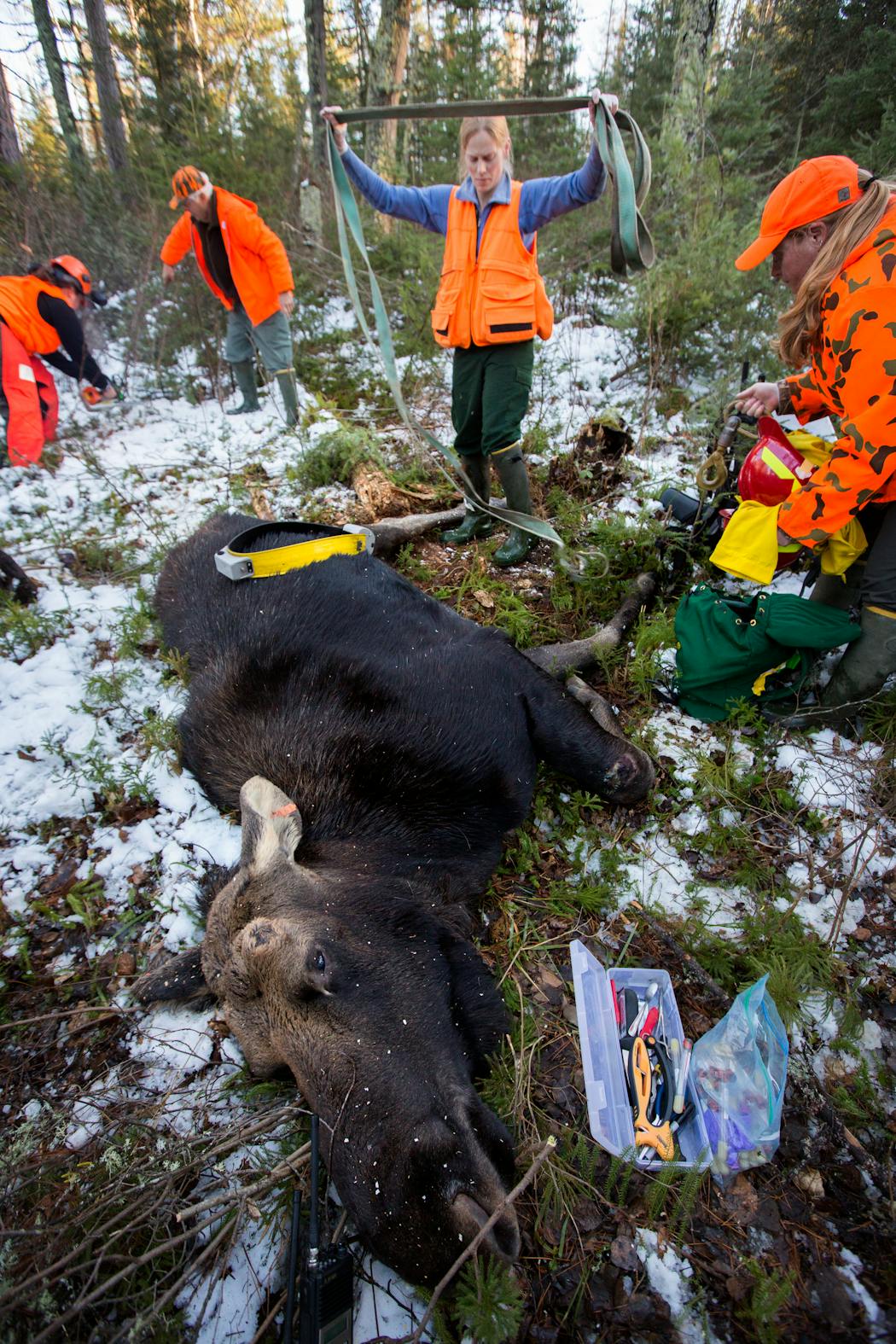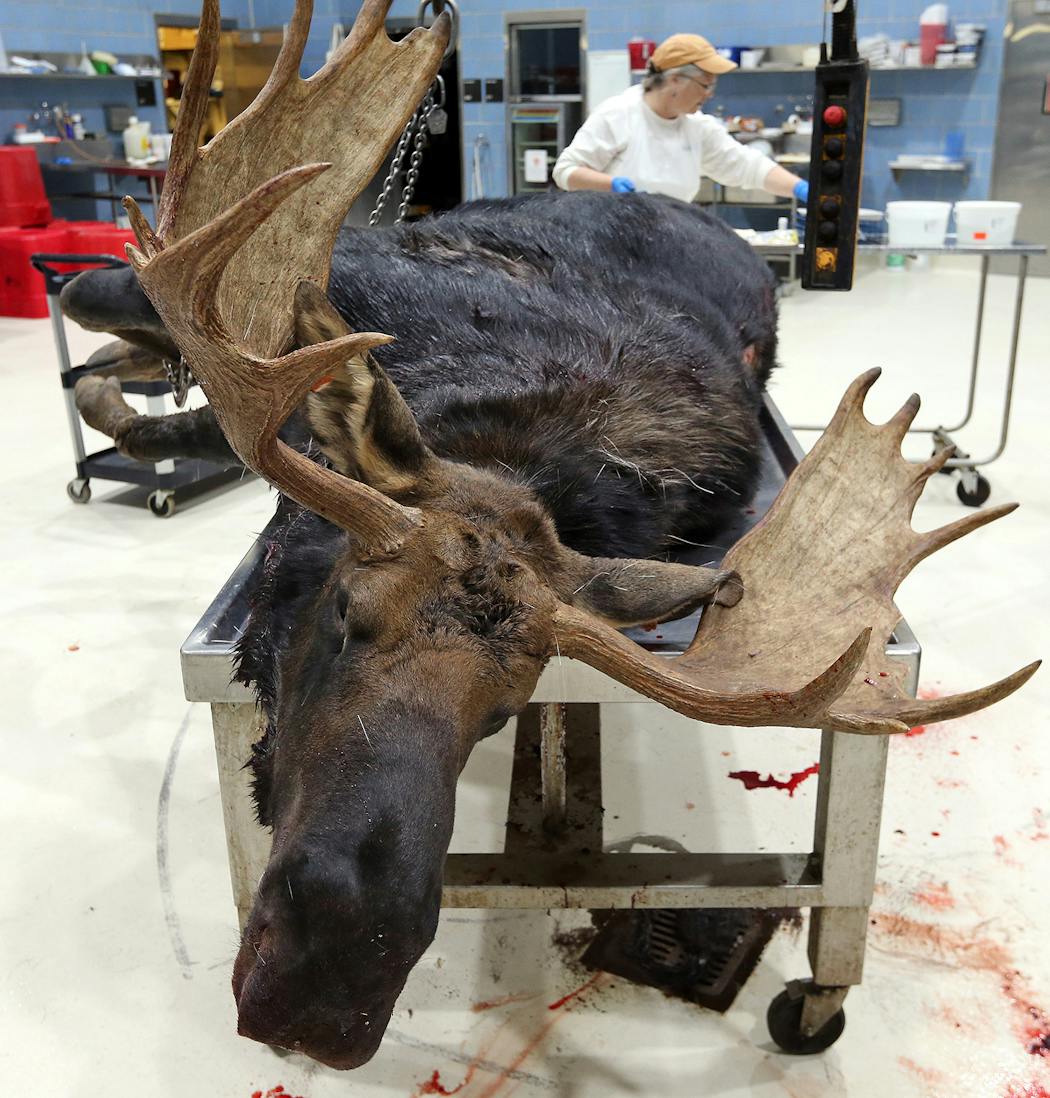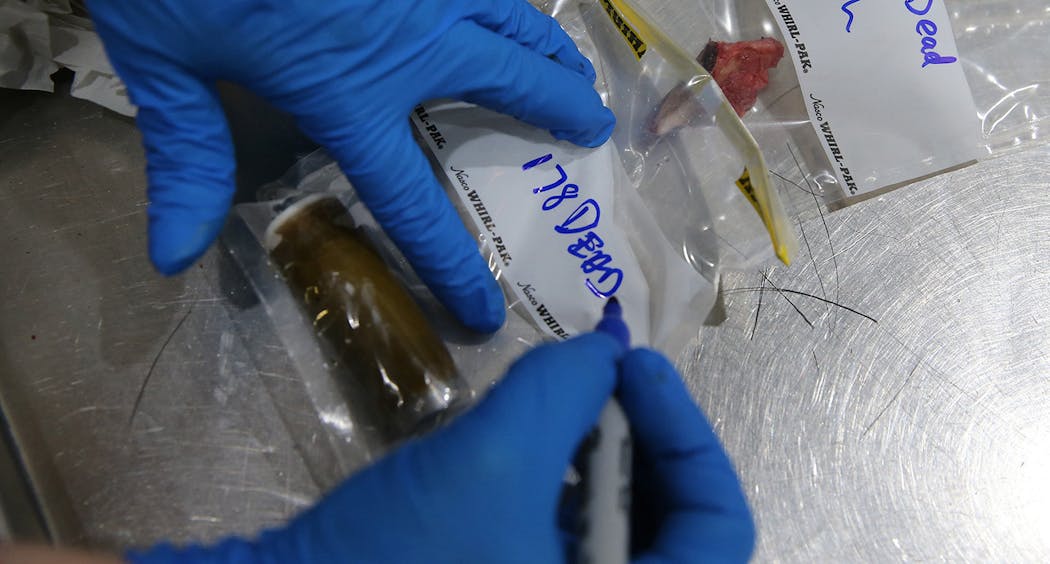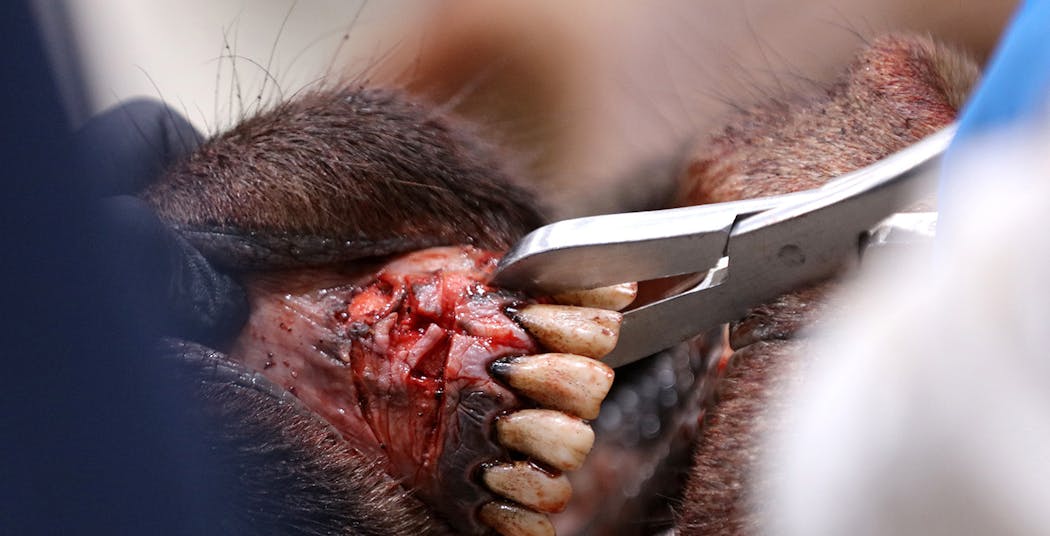When a moose goes down in the North Woods, it’s hauled out to a U lab. Researchers are finding hope for saving moose, but with tough tradeoffs.
TOWER, MINN.
The death of moose No. 161 was written in the snow.
Emaciated and sick, he had bedded down deep in the North Woods. In his final struggle to rise, he plowed a dark furrow across the white ground before collapsing beneath a towering white pine.
Ordinarily, his carcass would have melted slowly into the earth. But within 24 hours, it was hoisted away by helicopter — one of 47 dead moose that scientists have airlifted, dragged or tobogganed out of the woods in an extraordinary project to find out why the massive animals are disappearing from Minnesota.
Now, answers to that mystery are at last beginning to emerge — as are some of the dilemmas they will present to the state.
Saving the moose might be possible, but it will require painful sacrifices and a delicate touch in balancing the diverse animal species that make their home in an ever-changing forest. It could mean reducing deer herds — and angering hunters. Or bringing back the wolf hunt — if federal courts allow it. Or letting northern forests burn to encourage the young trees that moose like to eat. Or choosing moose over money from timber and mining.
Then there is the most daunting question of all: whether moose can survive the dire consequences of climate change on their wet, woodsy habitat and — with a helping human hand — find a way to survive south of the Canadian border.
"There are people out there … who think that in the face of climate change there is no point in doing anything for moose — that we are wasting our money," said Mike Schrage, wildlife manager for the Fond du Lac Band of Chippewa. "But I have not given up on science and technology to help us out."
'So closely tied to moose'
Every October, the North Shore town of Grand Marais celebrates Moose Madness, a weekend festival that attracts thousands of visitors and $250,000 in tourism business. There's a moose scavenger hunt, poetry writing contests, Murray the Moose to entertain the kids, and chocolate candies that are indistinguishable from moose poop, though thankfully they're called moose balls.
"We are so closely tied to moose, it feels like it will always be part of our land, our spirit and our home," said Kjersti Vick, who helps organize the festival for the Cook County Visitors Bureau.
From the Duluth Pack logo, to the Chocolate Moose restaurant in Ely, to the cartoon hometown of Rocky and Bullwinkle (Frostbite Falls, Minn.), moose are everywhere in northeastern Minnesota.
Except, increasingly, where they belong: in the woods.
There's far more than a cute mascot at stake. Moose are a key measure of the forest's health — whether it has the right mix of trees, for example, and the right balance of predators — and a test of whether society can manage a treasured ecosystem in transition.
In the northwest part of Minnesota, where they once thrived, moose have been gone for years. In the northeastern corner, the state's annual survey counted fewer than 3,000 in 2013 — a perilous drop of two-thirds in less than a decade.
The prospect of a Minnesota without moose galvanized the Legislature and state wildlife managers to launch one of the most ambitious research studies ever done on the animal. Using collars rigged with satellite communications technology, Department of Natural Resources (DNR) wildlife officers have tracked 173 moose — where they go, when they calve, and even forest temperatures. The project's scale and sophistication have captured the attention of moose researchers around the world.
Most importantly, it tells researchers when and where an animal has lain down to die, an event that triggers a CSI-like SWAT team that swoops in on ATVs, snowmobiles, or foot to gather the evidence and the body.
That could be in a swamp, by a road — or, as in the case of moose No. 161, in a boggy, wooded area at the bottom of a steep hill by an old clear-cut.
Airlifting a carcass
The little device that researchers had pushed down the moose's throat when he was captured and sedated last March blasted out a bright red text message to an array of DNR cellphones and computers: "MORTALITY IMPLANT EVENT DETECTED."
The text told wildlife officer Dawn Plattner, who was on call that Saturday in mid-November, which moose was down and where he was. But it couldn't tell her what she could plainly see the next morning when she finally found his long brown body stretched out in the snow. The only way to get him out was by helicopter.
He had been dead for about a day. Miraculously, neither wolves nor ravens had found his carcass yet. He was intact.
And she was in luck — a helicopter was available.
By midday, a crew of four DNR wildlife officers and one volunteer had gathered deep in the woods, on a logging road about a mile from the carcass. They loaded up chain saws, cans of gasoline, a motorized winch, heavy straps, and knives and, with loaded plastic garbage cans strapped to their backs, headed across the clear-cut to get him ready.
The scream of chain saws shattered the winter silence as the team cleared away trees and brush. Plattner threaded wide-webbed straps between the bones on the moose's back legs.
"Boy, they are really on time," she said as the thump-thump of the helicopter came drifting over the trees.
Working feverishly in the darkening day, the crew winched the moose across the ground into the center of the clearing they'd cut. One of the two pilots stepped into the clearing to guide the helicopter. Gazing upward with a radio clamped in his mouth, he reached up and snagged the end of a line that trailed down from the chopper's belly and hooked it onto the straps knotted on the moose.
He stepped back, and, like a giant bird slowly unfurling from the ground, moose No. 161 flew up and away into the sky.
Brainworm
The next day, the autopsy at the University of Minnesota's veterinary diagnostic lab found that, like most of the dead moose studied so far, No. 161 just wasn't healthy.
He'd died from starvation and a massive infection that likely started from a wound in his front leg.
Of the 47 moose autopsied so far, 66 percent died from infection, parasites or illness. The rest were killed by wolves.
It's an average annual death rate of about 15 percent for the collared moose — a bit lower than the 21 percent documented in earlier studies. But it's still too high to sustain the species in Minnesota.
Still, the lessons emerging from that diagnostic lab offer tantalizing hope that a tweak here or there in the living matrix that surrounds Minnesota's moose could tilt the odds in their favor. But each change comes with its own hard choices.
Take deer. Historically, they kept more to the southern part of Minnesota. But humans have opened a path for deer into the North Woods by the steady spread of logging, farming, development and warmer winters. As they moved north, deer brought a parasite — brainworm — which deer can survive but moose cannot. It burrows into their brain, often causing a distinctive head tilt and tendency to walk in circles.
Biologists have known about the brainworm problem for some time, but now Michelle Carstensen, the DNR's lead moose researcher, estimates that 21 percent or more of the moose in Minnesota are dying from brainworm, or are vulnerable to wolves because of it.
No one knows what the healthy balance is between deer and moose — if any, she said. Today, thanks to some harsh winters and state management decisions designed to protect moose, deer are at their lowest number in decades.
CAUSES OF MOOSE MORTALITY, 2013-2016
Of 47 documented moose deaths from February 2013 to January 2016, most were from illness.
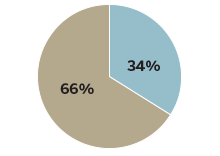
PREDATION
| 16 | Confirmed and suspected wolf kills |
HEALTH RELATED
| 15 | Parasites (brainworm, winter ticks, liver flukes, other parasites) |
| 10 | Bacterial infection/ predator related |
| 5 | Undetermined health problems |
| 1 | Accident |
Even so, it's "enough to have a significant impact on moose," said Schrage, the Fond du Lac wildlife manager.
In contrast, just a few miles away on Isle Royale in Lake Superior, there are no deer, and moose are flourishing. Rolf Peterson, a Michigan Technological University researcher who has studied wolves and moose on the island for many years, said brainworm is one of the primary reasons moose are declining on the mainland.
Others say that overlap between the species is inevitable.
"It's not a deer vs. moose equation," said Craig Engwall, head of the Minnesota Deer Hunters Association, which also supports moose habitat projects.
Last year, thanks largely to pressure from hunters frustrated by a shortage of deer, the DNR decided to let deer numbers increase slightly in much of moose territory.
"Not too long ago there used to be a lot of orange here in town" during deer hunting season, said Kelly Shepard, who's been guiding hunters and anglers for 40 years around the North Shore and Grand Marais. "My heritage is my livelihood and I want to see it continue."
Allowing deer numbers to increase wasn't an easy decision. In fact, in a sign of the kind of conflicts that could arise over wildlife management, the committee charged with advising the DNR on deer fell apart over a number of disagreements, including the animals' risk to moose.
Steve Merchant, the DNR's deer manager, said that the agency is ready to "follow the data" on the right balance of deer and moose when the research is completed. But what if that means little or no deer in moose range?
"That will be a tough one," he said.
Wolves' piece of the puzzle
Part of the problem, Merchant said, is that hunters don't see it as deer vs. moose. They see it as wolves, period.
The DNR research project shows that predators have killed just over a third of the adult moose in the study. But that's a surprise in itself, since a full-grown, healthy moose can crush a wolf's skull with a blow from its hoof. And in a parallel study, predators killed three-fourths of 40 collared moose calves before the research was halted last year over controversy about its impact on the newborn animals.
CURRENT RANGE AND MONITORED DEATHS
Minnesota's remaining moose are found in the tip of the Arrowhead region. Here's where the 47 moose that died during the 2013-15 monitoring period were found, and how they died, according to forensic evidence.
Moose range
Sources: Minnesota Department of Natural Resources, University of Minnesota, NCompass TechnologiesBut Carstensen said the signs of bloody struggle that her teams find in the snow after a wolf kill tell just part of the story. Of the 16 moose killed by wolves, a third were sick and the health of the rest could not be determined, Carstensen said. In short, wolves are doing their job of ensuring the survival of the fittest: They kill the old and, most importantly in the case of Minnesota's moose, the sick.
"And that is why our population is in decline," Carstensen said. "They are simply health-compromised."
No question, biologists say, that bringing down wolf numbers could help moose. Wolves long ago saturated all the territory that's available to them in the state, and they're hungry.
"The measure of that is that you can feel every bone in their bodies," said Dave Mech, a scientist with the U.S. Geological Survey who collars Minnesota wolves for research.
But for now human hands are tied. Hunting has been off the table since 2014, when the wolf was once again placed on the federal endangered species list until a long-running legal fight about its status winds its way through the courts.
The return of a wolf hunt would probably generate yet another round of passionate public debate over a predator that is loved and hated. And, in an outcome that only complicates the management of moose populations, it would likely benefit deer, the wolf's favorite prey, even more.
Too warm to eat
Still, shifting the balance between predator and prey would not address the biggest threat of all, one that is likely to transform all of the North Woods: climate change.
If predictions about Minnesota's future come to pass, the southern edge of the boreal forest will move north in the next century, to be replaced by grasses and brush, a few scattered trees, and bare rock rising from the ground.
Graphic by Mark Boswell and Michael Grant, Star Tribune
Moose don't do well in higher temperatures, especially in winter. And now there are tantalizing hints about why.
For the last three years, DNR researcher Glenn DelGiudice has used moose urine samples to measure the animals' nutritional level, and matched it against winter temperatures. He found that the more often temperatures are above 23 degrees, the worse off moose are nutritionally. In short, at higher temperatures they don't seem to eat enough.
DelGiudice said he needs more research to draw firm conclusions, but clearly, he said, "they are very sensitive." Even when they are near a smorgasbord of good forage, he said, "If it's too warm, it doesn't matter."
Earlier springs also raise the specter of more parasites surviving the winter. Three of the collared moose died from winter ticks, a parasite they should be able to survive. In New Hampshire and Maine, winter ticks are the primary factor in a similar moose decline. There, researchers are finding moose with hundreds of thousands of winter ticks that drain them of blood and, in a frenzy of scratching, drive them to scrape off their winter coats.
iologists say the prospects are not hopeless. Moose, they say, are roaming around the far warmer plains of North Dakota and agricultural regions of Alberta, Canada. They may be surviving because these regions have no wolves, and because they can conserve their energy by foraging in the highly caloric fields of wheat, alfalfa and chick peas they find in those areas, scientists said.
"What this says is potentially we can manage," said Ron Moen, a professor at the University of Minnesota Duluth, who is studying where moose go when they're hot. Give them enough of the young trees they need for food, and enough places to cool off, and they might do fine in the far northern reaches of Minnesota, he said.
But even that hopeful prospect raises difficult questions, because any effort to manage forests to help moose survive would touch on two of northern Minnesota's largest industries — forestry and mining. The DNR, which helps manage millions of acres of state-owned wilderness, is developing a new long-term plan for those lands, and it will probably include increasing revenue through timber sales.
Minnesota regulators are also reviewing a proposed copper-nickel mine near Hoyt Lakes — and approval could pave the way for a brand-new industry in the heart of moose country. Last month, the U.S. Environmental Protection Agency said one of the lingering environmental questions the state must resolve is the mine's potential effect on moose. "There are lots of big questions about which trade-offs are going to be agreeable," Carstensen said.
Moose signals
For now, Carstensen and her wildlife CSI teams are rooting for the moose.
On a rainy night in mid-August, the DNR's Plattner got a text message saying cow No. 37 hadn't moved for six hours — a potential "mortality event." Early the next morning, she headed out with assistant wildlife manager Bailey Petersen to track the cow down.
For hours they walked in the pouring rain, following a signal from the cow's collar in ever tighter concentric circles, stumbling through a clear-cut and dense thickets. Finally Petersen stopped.
"This is it," she said. "This is the spot."
It was empty.
"Did she boogie on us?" Plattner asked.
Just then, her phone pinged with messages from the DNR office. Cow No. 37 had indeed taken off across the clear-cut. For the research team, it was another "wild moose chase." But it was also good news, because somewhere out there in the rain was a live moose they had thought was dead.
The happy texts started rolling in.
"Go moose!"
Josephine Marcotty • 612-673-7394
Brian Peterson • 612-673-4783

